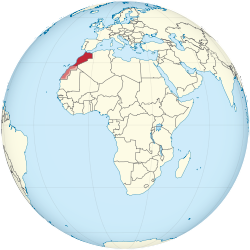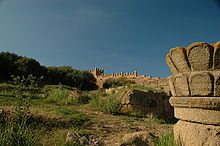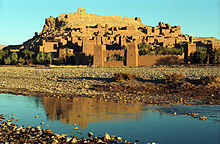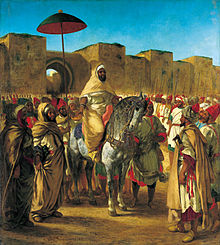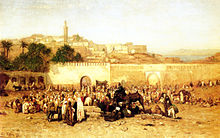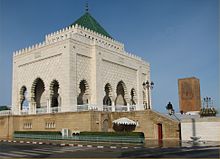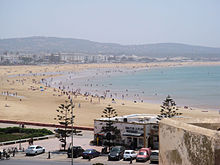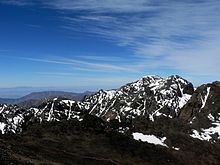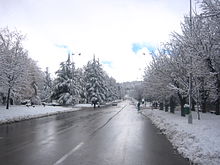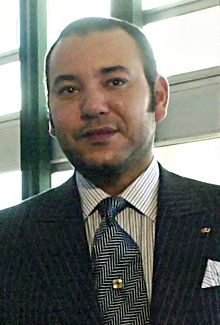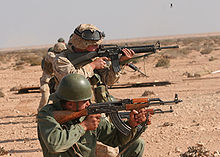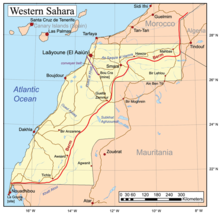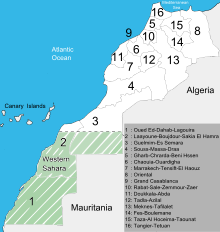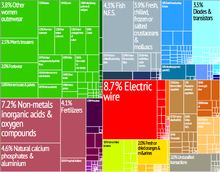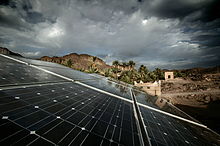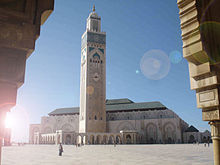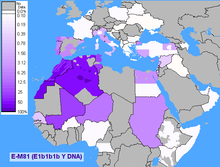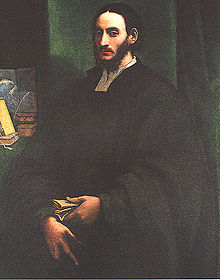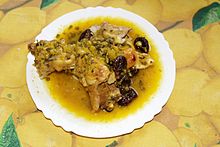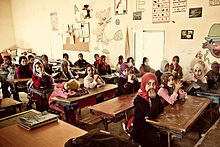
Morocco
About this schools Wikipedia selection
This content from Wikipedia has been selected by SOS Children for suitability in schools around the world. Before you decide about sponsoring a child, why not learn about different sponsorship charities first?
| Kingdom of Morocco | ||||||
|---|---|---|---|---|---|---|
|
||||||
| Motto: الله، الوطن، الملك (Arabic)
Allāh, al-Waṭan, al-Malik ⴰⴽⵓⵛ, ⴰⵎⵓⵔ, ⴰⴳⵍⵍⵉⴷ (Tamazight) "God, Homeland, King"Akuc, Amur, Agllid |
||||||
| Anthem: النشيد الوطني المغربي (Arabic) Cherifian Anthem |
||||||
|
Dark red: Internationally recognized territory of Morocco.
Lighter striped red: Western Sahara, a disputed territory mostly administered by Morocco as its Southern Provinces. |
||||||
| Capital | Rabat 34°02′N 6°51′W |
|||||
| Largest city | Casablanca | |||||
| Official languages |
|
|||||
| Native languages |
|
|||||
| Ethnic groups (2012) |
|
|||||
| Demonym | Moroccan | |||||
| Government | Unitary parliamentary constitutional monarchy | |||||
| - | King | Mohammed VI | ||||
| - | Prime Minister | Abdelillah Benkirane | ||||
| Legislature | Parliament | |||||
| - | Upper house | House of Councillors | ||||
| - | Lower house | House of Representatives | ||||
| Independence | ||||||
| - | from France | March 2, 1956 | ||||
| - | from Spain | April 7, 1956 | ||||
| Area | ||||||
| - | Total | 446,550 km2 or 710,850 km2 ( 58th or 40th) 172,487 sq mi |
||||
| - | Water (%) | 0.056 (250 km2) | ||||
| Population | ||||||
| - | 2012 estimate | 32,644,370 ( 38th) | ||||
| - | 2004 census | 29,680,069 | ||||
| - | Density | 73.1/km2 ( 122nd) 189.3/sq mi |
||||
| GDP ( PPP) | 2011 estimate | |||||
| - | Total | $162.617 billion ( 56th) | ||||
| - | Per capita | $5,052 ( 115th) | ||||
| GDP (nominal) | 2011 estimate | |||||
| - | Total | $99.241 billion ( 60th) | ||||
| - | Per capita | $3,083 ( 120th) | ||||
| Gini (2007) | 40.9 medium |
|||||
| HDI (2011) | medium · 130th |
|||||
| Currency | Moroccan dirham ( MAD) |
|||||
| Time zone | WET ( UTC+0) | |||||
| - | Summer ( DST) | WEST ( UTC+1) | ||||
| Drives on the | right | |||||
| Calling code | +212 | |||||
| ISO 3166 code | MA | |||||
| Internet TLD | .ma | |||||
| a. | ^ French is also used in official government documents and by the business community, although it has no official status. | |||||
| b. | ^ 13.5% fluent, 19.5% partially fluent. | |||||
| c. | ^ See Languages of Morocco. | |||||
| d. | ^ Primarily Riffian, Shilha and Central Tamazight. | |||||
| e. | ^ Primarily Darija and Hassaniya. | |||||
| f. | ^ The area 446,550 km2 (172,410 sq mi) excludes all disputed territories, while 710,850 km2 (274,460 sq mi) includes the Moroccan-administered parts of Western Sahara (claimed as the Sahrawi Republic by the Polisario Front). | |||||
Morocco (Arabic: المغرب al-Maghrib ; Berber: ⴰⵎⵕⵕⵓⴽ or ⵍⵎⴰⵖⵔⵉⴱ Ameṛṛuk or Lmaġrib; French: Maroc), officially the Kingdom of Morocco. Arabic name al-Mamlaka al-Maghribiyyah (Arabic: المملكة المغربية) translates to "The Western Kingdom". Al-Maghrib (Arabic: المغرب), or Maghreb, meaning "The West", is commonly used. The Kingdom of Morocco is the most westerly of the North African countries. It has Atlantic and Mediterranean coastlines, and a rugged mountain interior.
Morocco has a population of over 32 million and an area of 446,550 km2 (172,410 sq mi); if Western Sahara is included that would be 710,850 km2 (274,460 sq mi). The political capital is Rabat, although the largest city is Casablanca; other major cities include Marrakesh, Tangier, Tetouan, Salé, Fes, Agadir, Meknes, Oujda, Kenitra, and Nador. Morocco has a history of independence not shared by its neighbours. Its rich culture is a blend of Arab, Berber (indigenous African) and also other African and European influences.
Morocco administers most of the disputed region of the Western Sahara as the Southern Provinces. The status of Western Sahara remains unresolved. Morocco annexed the territory in 1975 and a guerrilla war with pro-independence forces ended in 1991. U.N. efforts have failed to break the political deadlock.
Morocco is a constitutional monarchy with an elected parliament. The King of Morocco holds vast executive and legislative powers, including the power to dissolve the parliament. Executive power is exercised by the government but the king's decisions usually override those of the government if there is a contradiction. Legislative power is vested in both the government and the two chambers of parliament, the Assembly of Representatives and the Assembly of Councillors. The king can also issue decrees called dahirs which have the force of law.
The main religion is Islam. The official language is Literary Arabic. Moroccan Arabic, Berber and French are also spoken. Hassaniya Arabic, sometimes considered a variety of Moroccan Arabic, is spoken in parts of the southern provinces (Western Sahara).
Etymology
The full Arabic name al-Mamlakat al-Maghribiyyah (المملكة المغربية) translates to "The Western Kingdom". Al-Maghrib (المغرب), meaning "The West", is commonly used. For historical references, medieval Arab historians and geographers referred to Morocco as al-Maghrib al-Aqṣá (المغرب الأقصى, "The Farthest West") to distinguish it from neighboring historical regions called al-Maghrib al-Awsaṭ (المغرب الأوسط, "The Middle West", Algeria) and al-Maghrib al-Adná (المغرب الأدنى, "The Nearest West", Tunisia).
The English name "Morocco" originates from Spanish "Marruecos" or the Portuguese "Marrocos", from medieval Latin "Morroch", which referred to the name of the former Almoravid and Almohad capital, Marrakesh. In Persian Morocco is still called "Marrakesh". Until recent decades, Morocco was called "Marrakesh" in Middle Eastern Arabic. In Turkish, Morocco is called "Fas" which comes from the ancient Idrisid and Marinid capital, Fez.
The word "Marrakesh" is made of the Berber word combination Mour N Akoush (Mur N Akuc), meaning Land of God.
History
Prehistory and Antiquity
The area of present-day Morocco has been inhabited since Paleolithic times, at least since 200,000 BCE. During the Upper Paleolithic, the Maghreb was more fertile than it is today, resembling a savanna more than today's arid landscape. 22,000 years ago, the Aterian was succeeded by the Iberomaurusian culture, which shared similarities with Iberian cultures. Skeletal similarities have been suggested between the Iberomaurusian " Mechta-Afalou" burials and European Cro-Magnon remains. The Iberomaurusian was succeeded by the Beaker culture in Morocco.
Studies have discovered a close link between Berbers and the Saami of Scandinavia which confirms that the Franco-Cantabrian refuge area of southwestern Europe was the source of late-glacial expansions of hunter-gatherers that repopulated northern Europe after the last ice age.
North Africa and Morocco were slowly drawn into the wider emerging Mediterranean world by the Phoenicians who established trading colonies and settlements in the early Classical period. Substantial Phoenician settlements were at Chellah, Lixus and Mogador, with Mogador being a Phoenician colony as early as the early 6th century BC.
Morocco later became part of a North African empire head-quartered in Carthage. The earliest known independent Moroccan state was the Berber kingdom of Mauretania under king Bocchus I. This kingdom in northern Morocco, not to be confused with the present state of Mauritania, dates at least to 110 BCE.
From the 1st century BCE the region was part of the Roman Empire as Mauretania Tingitana. Christianity was introduced in the 2nd century CE and gained converts in the Roman towns, among slaves and some Berber farmers.
In the 5th century CE, as the Roman Empire declined, the region was invaded from the north first by the Vandals and then by the Visigoths. In the 6th century CE, northern Morocco became part of the East Roman, or Byzantine Empire. Throughout this time, however, the Berber inhabitants in the high mountains of the interior of Morocco remained unsubdued.
Early Islamic Era
In 670 CE, the first Islamic conquest of the North African coastal plain took place under Uqba ibn Nafi, a general serving under the Umayyads of Damascus. The Umayyad Muslims brought their language, their system of government, and Islam to Morocco. Many of the Berbers slowly converted to Islam, mostly after Arab rule had receded. The first independent Muslim state in the area of modern Morocco, was the Kingdom of Nekor, an emirate in the Rif Mountains. It was founded by Salih I ibn Mansur in 710, as a client state to the Rashidun Caliphate. After the outbreak of the Great Berber Revolt in 739, the Berbers formed other independent states such as the Miknasa of Sijilmasa and the Barghawata.
According to medieval legend, Idris ibn Abdallah had fled to Morocco after the Abbasids' massacre of his tribe in Iraq. He convinced the Awraba Berber tribes to break their allegiance to the distant Abbasid caliphs in Baghdad and he founded the Idrisid Dynasty in 788. The Idrisids established Fes as their capital and Morocco became a centre of Muslim learning and a major regional power. The Idrissids were ousted in 927 by the Fatimid Caliphate and their Miknasa allies. After Miknasa broke off relations with the Fatimids in 932, they were removed from power by the Maghrawa of Sijilmasa in 980.
Berber dynasties
From the 11th century onwards, a series of powerful Berber dynasties arose. Under the Almoravid dynasty and the Almohad dynasty, Morocco dominated the Maghreb, much of present-day Spain and Portugal, and the western Mediterranean region. In the 13th and 14th centuries the Merinids held power in Morocco and strove to replicate the successes of the Almohads by military campaigns in Algeria and Spain. They were followed by the Wattasids. In the 15th century, the Reconquista ended Muslim rule in central and southern Spain and many Muslims and Jews fled to Morocco. Portuguese efforts to control the Atlantic coast in the 15th century did not greatly affect the interior of Morocco. According to Elizabeth Allo Isichei, "In 1520, there was a famine in Morocco so terrible that for a long time other events were dated by it. It has been suggested that the population of Morocco fell from 5 to under 3 million between the early sixteenth and nineteenth centuries."
Sharifian dynasties
In 1549, the region fell to successive Arab dynasties claiming descent from the Islamic prophet, Muhammad: first the Saadi dynasty who ruled from 1549 to 1659, and then the Alaouite dynasty, who remained in power since the 17th century.
Under the Saadi Dynasty, the country repulsed Ottoman incursions and a Portuguese invasion at the battle of Ksar el Kebir in 1578. The reign of Ahmad al-Mansur brought new wealth and prestige to the Sultanate, and a large expedition to West Africa inflicted a crushing defeat on the Songhay Empire in 1591. However, managing the territories across the Sahara proved too difficult. After the death of al-Mansur the country was divided among his sons.
In 1666 Morocco was reunited by the Alaouite Dynasty, who have been the ruling house of Morocco ever since. Morocco was facing aggression from Spain and the Ottoman Empire pressing westward. The Alaouites succeeded in stabilizing their position, and while the kingdom was smaller than previous ones in the region, it remained quite wealthy. Against the opposition of local tribes Ismail Ibn Sharif (1672–1727) began to create a unified state. With his Jaysh d'Ahl al-Rif (the Riffian Army) he seized Tangier from the English in 1684 and drove the Spanish from Larache in 1689.
Morocco was the first nation to recognize the fledgling United States as an independent nation in 1777. In the beginning of the American Revolution, American merchant ships in the Atlantic Ocean were subject to attack by the Barbary Pirates. On 20 December 1777, Morocco's Sultan Mohammed III declared that American merchant ships would be under the protection of the sultanate and could thus enjoy safe passage. The Moroccan-American Treaty of Friendship stands as the U.S.'s oldest non-broken friendship treaty.
French and Spanish protectorates
After the Napoleonic Wars, the Maghreb was increasingly ungovernable from Istanbul, and became the resort of pirates under local beys. As Europe industrialized, North Africa was increasingly prized for its potential for colonization. France showed a strong interest in Morocco as early as 1830. In 1860, a dispute over Spain's Ceuta enclave led Spain to declare war. Victorious Spain won a further enclave and an enlarged Ceuta in the settlement. In 1884, Spain created a protectorate in the coastal areas of Morocco.
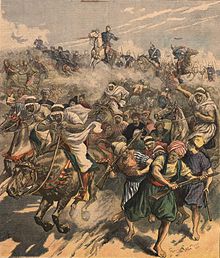
In 1904, France and Spain carved out zones of influence in Morocco. Recognition by the United Kingdom of France's sphere of influence provoked a strong reaction from the German Empire; and a crisis loomed in 1905. The matter was resolved at the Algeciras Conference in 1906. The Agadir Crisis provoked by the Germans, increased tensions between European powers. The 1912 Treaty of Fez made Morocco a protectorate of France. Spain continued to operate its coastal protectorate. By the same treaty, Spain assumed the role of protecting power over the northern and southern Saharan zones.
Tens of thousands of colonists entered Morocco and bought up large amounts of the rich agricultural land. Interest groups that formed among these elements continually pressured France to increase its control over Morocco. Many Moroccan soldiers ( Goumieres) served in the French army in both World War I and World War II, and in the Spanish Nationalist Army in the Spanish Civil War and after ( Regulares).
From 1921-6 a Berber uprising in the Rif Mountains, led by Abd el-Krim lead to the establishment of the Republic of the Rif. The rebellion was suppressed by French and Spanish troops.
In 1943, the Istiqlal Party (Independence Party) was founded to press for independence. That party subsequently provided most of the leadership for the nationalist movement.
France's exile of Sultan Mohammed V in 1953 to Madagascar and his replacement by the unpopular Mohammed Ben Aarafa sparked active opposition to the French and Spanish protectorates. The most notable violence occurred in Oujda where Moroccans attacked French and other European residents in the streets. France allowed Mohammed V to return in 1955, and the negotiations that led to Moroccan independence began the following year. In March 1956 the French protectorate was ended and Morocco regained its independence from France and Spain as the "Kingdom of Morocco". Spain kept its two coastal enclaves. Sultan Mohammed became king in 1957.
Reign of King Hassan II
Upon the death of King Mohammed, Hassan II became King of Morocco on March 3, 1961. Morocco held its first general elections in 1963. However, Hassan declared a state of emergency and suspended parliament in 1965. In 1971, there was a failed attempt to depose the king and establish a republic. A truth commission set up in 2005 to investigate human rights abuses during his reign confirmed nearly 10,000 cases, ranging from death in detention to forced exile. Some 592 people were recorded killed during Hassan's rule.
The Spanish enclave of Ifni in the south was returned to Morocco in 1969. The Polisario movement was formed in 1973, with the aim of establishing an independent state in the Spanish Sahara. On 6 November 1975 King Hassan asked for volunteers to cross into the Spanish Sahara. Some 350,000 civilians were reported as being involved in the " Green March". A month later, Spain agreed to leave the Spanish Sahara, soon to become Western Sahara, and to transfer it to joint Moroccan-Mauritanian control, despite the objections and threats of military intervention by Algeria. Moroccan forces occupied the territory.
Moroccan and Algerian troops soon clashed in Western Sahara. Morocco and Mauritania divided up Western Sahara. Fighting between the Moroccan military and Polisario forces contiuned for many years. The prolonged war was a considerable financial drain on Morocco. In 1983, Hassan cancelled planned elections amid political unrest and economic crisis. In 1984, Morocco left the Organisation of African Unity in protest at the SADR's admission to the body. Polisario claimed to have killed more than 5,000 Moroccan soldiers between 1982-85.
Diplomatic relations with Algeria were restored in 1988. In 1991, a U.N.-monitored ceasefire began in Western Sahara, but the territory's status remains undecided and ceasefire violations are reported. The following decade saw much wrangling over a proposed referendum on the future of the territory but the deadlock was not broken.
Political reforms in the 1990s resulted in the establishment of a bicameral legislature in 1997 and Morocco's first opposition-led government came to power in 1998.
Reign of Mohammed VI
King Hassan II died in 1999 and was succeeded by his son, Mohammed VI. He is a cautious moderniser who has introduced some economic and social liberalisation.
King Mohammed paid a controversial visit to the Western Sahara in 2002. Morocco unveiled an autonomy blueprint for Western Sahara to the United Nations in 2007. The Polisario rejected the plan and put forward its own proposal. Morocco and the Polisario Front held U.N.-sponsored talks in New York but failed to come to any agreement. In 2010, security forces stormed a protest camp in the Western Sahara, triggering violent demonstrations in the regional capital El Aaiún.
In 2002, Morocco and Spain agreed to a US-brokered resolution over the disputed island of Perejil. Spanish troops had taken the normally uninhabited island after Moroccan soldiers landed on it and set up tents and a flag. There were renewed tensions in 2005 as hundreds of African migrants tried to storm the borders of the Spanish enclaves of Melilla and Ceuta. Morocco deported hundreds of the illegal migrants. In 2006 the Spanish Premier Zapatero visited Spanish enclaves. He was the first Spanish leader in 25 years to make an official visit to the territories. The following year, Spanish King Juan Carlos visited Ceuta and Melilla, further angering Morocco which demanded the return of the enclaves.
In February 2003, a Casablanca court jailed three Saudi members of al-Qaeda for 10 years after they were accused of plotting to attack US and British warships in the Straits of Gibraltar. Three months later, more than 40 people were killed in the 2003 Casablanca bombings, when suicide bombers attacked several sites in Casablanca, including a Spanish restaurant and Jewish community centre.
In the 2007 Casablanca bombings, three suspected suicide bombers blew themselves up, a few weeks after a suicide blast in an internet cafe that injured three. More than 40 people were given long prison sentences for this bombing. Two suicide bombers blew themselves up outside the US diplomatic offices in Casablanca.
In 2008, two Moroccan men, Abdelilah Ahriz and Hicham Ahmidan, were sentenced to 20 and 10 years in jail respectively in Morocco over the Madrid train bombings of 2004. Islamist Saad Housseini was given 15-year sentence in 2009 over the 2003 Casablanca bombings. He was also wanted in Spain over the Madrid bombings. Soon after, the alleged al-Qaeda leader in Morocco, Belgian-Moroccan Abdelkader Belliraj, was imprisoned for life on being found guilty of leading an Islamist militant group and committing six murders in Belgium.
In the April 2011 Marrakech bombing, 17 people, mainly foreigners, were killed in a bomb attack on a Marrakech cafe. The Maghreb arm of al-Qaeda denied involvement. A man was later sentenced to death for the bombing.
In the 2011–2012 Moroccan protests, thousands of people rallied in Rabat and other cities calling for political reform and a new constitution curbing the powers of the king. In July 2011 the King won a landslide victory in a referendum on a reformed constitution he had proposed to placate the Arab Spring protests.
Demonstrators continued to call for deeper reforms. Tens of thousands took part in a trade union rally in Casablanca in May 2012. Participants accused the government of failing to deliver on reforms.
Geography
Morocco has a coast on the Atlantic Ocean that reaches past the Strait of Gibraltar into the Mediterranean Sea. It is bordered by Spain to the north (a water border through the Strait and land borders with three small Spanish-controlled exclaves, Ceuta, Melilla, and Peñón de Vélez de la Gomera), Algeria to the east, and Western Sahara to the south. Since Morocco controls most of Western Sahara, its de facto southern boundary is with Mauritania.
The internationally recognized borders of the country lie between latitudes 27° and 36°N, and longitudes 1° and 14°W. Adding Western Sahara, Morocco lies mostly between 21° and 36°N, and 1° and 17°W (the Ras Nouadhibou peninsula is slightly south of 21° and west of 17°).
The geography of Morocco spans from the Atlantic Ocean, to mountainous areas, to the Sahara desert. Morocco is a Northern African country, bordering the North Atlantic Ocean and the Mediterranean Sea, between Algeria and the annexed Western Sahara.
A large part of Morocco is mountainous. The Atlas Mountains are located mainly in the centre and the south of the country. The Rif Mountains are located in the north of the country. Both ranges are mainly inhabited by the Berber people. At 446,550 km2 (172,414 sq mi), Morocco is the fifty-seventh largest country in the world (after Uzbekistan). Algeria borders Morocco to the east and southeast though the border between the two countries has been closed since 1994.
Spanish territory in North Africa neighbouring Morocco comprises five enclaves on the Mediterranean coast: Ceuta, Melilla, Peñón de Vélez de la Gomera, Peñón de Alhucemas, the Chafarinas islands, and the disputed islet Perejil. Off the Atlantic coast the Canary Islands belong to Spain, whereas Madeira to the north is Portuguese. To the north, Morocco is bordered by the Strait of Gibraltar, where international shipping has unimpeded transit passage between the Atlantic and Mediterranean.
The Rif mountains stretch over the region bordering the Mediterranean from the north-west to the north-east. The Atlas Mountains run down the backbone of the country, from the northeast to the south west. Most of the southeast portion of the country is in the Sahara Desert and as such is generally sparsely populated and unproductive economically. Most of the population lives to the north of these mountains, while to the south lies the Western Sahara, a former Spanish colony that was annexed by Morocco in 1975 (see Green March). Morocco claims that the Western Sahara is part of its territory and refers to that as its Southern Provinces.
Morocco's capital city is Rabat; its largest city is its main port, Casablanca. Other cities include Agadir, Essaouira, Fes, Marrakech, Meknes, Mohammadia, Oujda, Ouarzazat, Safi, Salé, Tangier and Tétouan.
Morocco is represented in the ISO 3166-1 alpha-2 geographical encoding standard by the symbol MA. This code was used as the basis for Morocco's internet domain, .ma.
Climate
The climate is Mediterranean in the North and in some mountains (West of Atlas), which becomes more extreme towards the interior regions. The terrain is such that the coastal plains are rich and accordingly, they comprise the backbone for agriculture, especially in the North. Forests cover about 12% of the land while arable land accounts for 18%; 5% is irrigated. In the Atlas (Middle Atlas), there are several different climates: Mediterranean (with some more humid and fresher variants), Maritime Temperate (with some humid and fresher variants too) that allow different species of oaks, moss carpets, junipers, atlantic cedars and many other plants, to form extensive and very rich humid cloud forests. The climate changes when moving east of the Atlas mountains due to the barrier, or shelter, effect of the mountain system, becoming very dry and extremely warm during the long summer, especially on the lowlands and on the valleys facing the Sahara. The Sahara Desert begins here, and it is perfectly visible, for example, on the Draa Valley, where it is possible to find oases, sand dunes and rocky desert landscapes.
Biodiversity
Morocco is known for its biodiversity; Avifauna being the most notable. The avifauna of Morocco includes a total of 454 species, five of which have been introduced by humans, and 156 are rarely or accidentally seen.
The Barbary lion, hunted to extinction in the wild, was a subspieces native to Morocco and is a national emblem. The last Barbary lion in the wild was shot in the Atlas Mountains in 1922. The other two primary predators of northern Africa, the Atlas bear and Barbary leopard, are now extinct and critically endangered, respectively.
Politics
Morocco is a parliamentary constitutional monarchy, whereby the Prime Minister of Morocco is the head of government, and of a multi-party system. Executive power is exercised by the government. Legislative power is vested in both the government and the two chambers of parliament, the Assembly of Representatives of Morocco and the Assembly of Councillors.
Following the March 1998 elections, a coalition government headed by opposition socialist leader Abderrahmane Youssoufi and composed largely of ministers drawn from opposition parties, was formed. Prime Minister Youssoufi's government was the first ever government drawn primarily from opposition parties, and also represents the first opportunity for a coalition of socialists, left-of-centre, and nationalist parties to be included in the government until October 2002. It was also the first time in the modern political history of the Arab world that the opposition assumed power following an election. The current government is headed by Abdelilah Benkirane.
The Moroccan Constitution provides for a monarchy with a Parliament and an independent judiciary. With the 2011 constitutional reforms, the King of Morocco still retains few executive powers whereas those of the prime minister have been enlarged.
The constitution grants the king honorific powers; he is both the secular political leader and the "Commander of the Faithful" as a direct descendant of the Prophet Mohammed. He presides over the Council of Ministers; appoints the Prime Minister from the political party that has won the most seats in the parliamentary elections, and on recommendations from the latter, appoints the members of the government.
The previous constitution of 1996 theoretically allowed the king to terminate the tenure of any minister, and after consultation with the heads of the higher and lower Assemblies, to dissolve the Parliament, suspend the constitution, call for new elections, or rule by decree, the only time this happened was in 1965. The King is formally the chief of the military.
Legislative branch
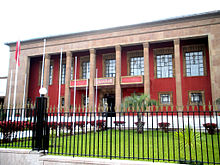
Since the constitutional reform of 1996, the bicameral legislature consists of two chambers. The Assembly of Representatives of Morocco (Majlis an-Nuwwâb/Assemblée des Répresentants) has 325 members elected for a five-year term, 295 elected in multi-seat constituencies and 30 in national lists consisting only of women. The Assembly of Councillors (Majlis al-Mustasharin) has 270 members, elected for a nine-year term, elected by local councils (162 seats), professional chambers (91 seats) and wage-earners (27 seats).
The Parliament's powers, though still relatively limited, were expanded under the 1992 and 1996 and even further in the 2011 constitutional revisions and include budgetary matters, approving bills, questioning ministers, and establishing ad hoc commissions of inquiry to investigate the government's actions. The lower chamber of Parliament may dissolve the government through a vote of no confidence.
The latest parliamentary elections were held on November 25, 2011, and were considered by some neutral observers to be mostly free and fair. Voter turnout in these elections was estimated to be 43% of registered voters.
Military
Compulsory military service in Morocco has been officially suppressed since September 2006, and the country’s reserve obligation lasts until age 50. The country’s military consists of the Royal Armed Forces—this includes the army (the largest branch) and a small navy and air force—the National Police Force, the Royal Gendarmerie (mainly responsible for rural security), and the Auxiliary Forces. Internal security is generally effective, and acts of political violence are rare (with one exception, the 2003 Casablanca bombings which killed 45 people). The U.N. maintains a small observer force in Western Sahara, where a large number of Morocco’s troops are stationed. The Saharawi group Polisario maintains an active militia of an estimated 5,000 fighters in Western Sahara and has engaged in intermittent warfare with Moroccan forces since the 1980s.
Foreign relations
Morocco remains the only African state not to be a member of the African Union due to its unilateral withdrawal on November 12, 1984 over the admission of the Sahrawi Arab Democratic Republic (SADR) in 1982 by the African Union as a full member without the organization of a referendum of self-determination in the disputed territory of Western Sahara.
A dispute with Spain in 2002 over the tiny island of Perejil revived the issue of the sovereignty of Melilla and Ceuta. These small enclaves on the Mediterranean coast are surrounded by Morocco and have been administered by Spain for centuries.
Morocco has been given the status of non-Nato ally by Washington.
Western Sahara status
Because of the conflict over Western Sahara, the status of both regions of " Saguia el-Hamra" and " Río de Oro" is disputed. The Western Sahara War saw the Sahrawi rebel national liberation movement Polisario Front battling Morocco and Mauritania from 1976 to 1991. There is a ceasefire in effect since 1991, and a U.N. mission ( MINURSO) is tasked with organizing a referendum on whether the territory should become independent or recognized as a part of Morocco.
Part of the territory, the Free Zone, is a mostly uninhabited area controlled by the Polisario Front as the Sahrawi Arab Democratic Republic with Headquarters at Tindouf in Algeria. As of 2006, no U.N. member state has recognized Moroccan sovereignty over Western Sahara.
In 2006, the government of Morocco has suggested autonomous status for the region, through the Moroccan Royal Advisory Council for Saharan Affairs (CORCAS). The project was presented to the United Nations Security Council in mid-April 2007. The proposal was encouraged by Moroccan allies such as the United States, France and Spain. The Security Council has called upon the parties to enter into direct and unconditional negotiations to reach a mutually accepted political solution.
Administrative divisions
Morocco is divided into 16 regions, and subdivided into 62 prefectures and provinces.
- Oued Ed-Dahab-Lagouira
- Laâyoune-Boujdour-Sakia El Hamra
- Guelmim-Es Semara
- Souss-Massa-Drâa
- Gharb-Chrarda-Béni Hssen
- Chaouia-Ouardigha
- Marrakech-Tensift-El Haouz
- Oriental
- Grand Casablanca
- Rabat-Salé-Zemmour-Zaer
- Doukkala-Abda
- Tadla-Azilal
- Meknès-Tafilalet
- Fès-Boulemane
- Taza-Al Hoceima-Taounate
- Tangier-Tétouan
Economy
Morocco's economy is considered a relatively liberal economy governed by the law of supply and demand. Since 1993, the country has followed a policy of privatization of certain economic sectors which used to be in the hands of the government.
Government reforms and steady yearly growth in the region of 4–5% from 2000 to 2007, including 4.9% year-on-year growth in 2003–2007 helped the Moroccan economy to become much more robust compared to a few years ago. For 2012 the World Bank forecasts a rate of 4% growth for Morocco and 4.2% for following year, 2013.
The services sector accounts for just over half of GDP and industry, made up of mining, construction and manufacturing, is an additional quarter. The industries that recorded the highest growth are tourism, telecoms, information technology, and textile.
Agriculture accounts for only around 14% of GDP but employs 40–45% of the Moroccan working population. With a semi-arid climate and an ill-developed irrigation system, it is difficult to assure enough irrigation. Morocco’s economy depends heavily on the weather, a typical characteristic of third-world countries.
The major resources of the Moroccan economy are agriculture, phosphates, and tourism. Sales of fish and seafood are important as well. Industry and mining contribute about one-third of the annual GDP. Morocco is the world's third-largest producer of phosphorus after China and the United States, and the price fluctuations of phosphates on the international market greatly influence Morocco's economy.
Morocco suffers both from unemployment (9.6% in 2008), and a large external debt estimated at around $20 billion, or half of GDP in 2002.
Although Morocco runs a structural trade deficit, this is typically offset by substantial services earnings from tourism and large remittance inflows from the diaspora, and the country normally runs a small current-account surplus.
Energy
In 2008, about 56% of the electricity source of Morocco came from coal. However, as forecasts indicate that energy requirements in Morocco will rise 6% per year between 2012 and 2050, a new law passed encouraging Moroccans to look for ways to diversify the energy supply, including more renewable resources. The Moroccan government has launched a project to build a solar thermal energy power plant and is also in looking into the use of Natural Gas as a potential source of revenue for Morocco’s government.
Morocco has embarked upon the construction of large solar energy farms to lessen dependence on fossil fuels, and to eventually export electricity to Europe.
Narcotics
Cannabis has been cultivated in the Rif Region since the 7th century. According to the U.N. 2004 World Drugs Report, cultivation and transformation of Cannabis represents 0.57% of the national GDP of Morocco in 2002. Around 88% of the cannabis consumed in Europe comes from the Rif region in Morocco. In addition to that, Morocco is a transit point for cocaine from South America destined for Western Europe.
Transport
There are around 56,986 km (35,409 mi) of roads (national, regional and provincial) in Morocco. In addition to 610.5 km (379.3 mi) kilometre of highways.
The Tangier-Casablanca high-speed rail link marks the first stage of the ONCF’s high-speed rail master plan, pursuant to which over 1,500 km (930 mi) of new railway lines will be built by 2035 The high speed train -TGV- will carry 8 million passengers per year. It will have a capacity of 500 passengers. the work in the High Speed Train project has started in September 2011 and the infrastructure works and railway equipment will end in 2014, and the HST will be operational in December 2015.
Demographics
| Populations (in thousands) | ||
|---|---|---|
| Year | Pop. | ±% p.a. |
| 1960 | 11,635 | — |
| 1971 | 15,357 | 2.52% |
| 1982 | 20,334 | 2.55% |
| 1994 | 25,996 | 2.05% |
| 2004 | 29,840 | 1.38% |
| Source: Source | ||
Most Moroccans are of mixed Arab-Berber, Arab, Berber and Niger-Congo ethnic background. Arabs and Berbers make up about 99.1% of the Moroccan population.
Berbers are the indigenous people and still make up the bulk of the population (although largely Arabized). A sizeable portion of the population is identified as Haratin and Gnawa (or Gnaoua), black or mixed race. Morocco's Jewish minority (265,000 in 1948) has decreased significantly and numbers about 5,500.
Most of the 100,000 foreign residents are French or Spanish. Some of them are colonists' descendants, who primarily work for European multinational companies, others are married to Moroccans and preferred to settle in Morocco. Prior to independence, Morocco was home to half a million Europeans.
The largest concentration of Moroccan migrants outside Morocco is in France, which has reportedly over one million Moroccans of up to the third generation. The Netherlands hosts about 360,000 Moroccans and Belgium hosts about 300,000 Moroccans. There are also large Moroccan communities in Spain (about 700,000 Moroccans), Italy, Israel, Canada and the United States. Moroccan Jews are thought to constitute the second biggest Jewish ethnic subgroup in Israel.
Religion
The population of Morocco is 98.7% Muslim, 1.1% Christian, and 0.2% Jewish. According to Jewish community leaders, there are an estimated 3,000 to 4,000 Jews, approximately 2,500 of whom reside in Casablanca and are the remnants of a much larger community that has mostly emigrated. The most recent estimates put the size of the Rabat and Marrakesh Jewish communities at about 100 members each. The remainder of the Jewish population is dispersed throughout the country. This population is mostly elderly, with a decreasing number of young persons.
The predominantly Roman Catholic and Protestant foreign-resident Christian community consists of approximately 5,000 practicing members, although some Protestant and Catholic clergy estimate the number to be as high as 25,000. Most foreign resident Christians reside in the Casablanca, Tangier, and Rabat urban areas. Various local Christian leaders estimate that there are 4,000 citizen Christians (mostly ethnically Berber) who regularly attend “house” churches and live predominantly in the south. Some local Christian leaders estimate that there may be as many as 8,000 Christian citizens throughout the country, but many reportedly do not meet regularly due to fear of government surveillance and social persecution.
There are an estimated 3,000 to 8,000 Shia Muslims, most of them foreign residents from Lebanon or Iraq, but also a few citizen converts. Followers of several Sufi Muslim orders across the Maghreb and West Africa undertake joint annual pilgrimages to the country. The Baha’i community, located in urban areas, numbers 350 to 400 persons.
Languages
Morocco's official languages are Arabic and Berber. The country's distinctive group of Moroccan Arabic dialects is referred to as Darija. Approximately 89.84% of the whole population can communicate to some degree in Moroccan Arabic. The Berber language is spoken in three dialects ( Tarifit, Tashelhit and Central Atlas Tamazight). In 2000s, there was 15 to 18 million Berber speakers, making up about 45% to 54% of the population. The 2004 population census says that 28.07% of the population speak Berber.
French is widely used in governmental institutions, media, mid-size and large companies, international commerce with French speaking countries, and often in international diplomacy. French is taught as an obligatory language at all schools. In 2010, there were 10,366,000 French-speakers in Morocco, or about 32% of the population.
According to the 2004 census, 2.19 million Moroccans spoke a foreign language other than French. English, while far behind French in terms of number of speakers, is the first foreign language of choice, since French is obligatory, among educated youth and professionals. Spanish is spoken by a very small population in the north of the country, especially around the Spanish enclaves Melilla and Ceuta.
Genetics
Recent studies make clear no significant genetic differences exist between Arabic and non-Arabic speaking populations, HLA DNA data suggest that most Moroccans are of a Berber origin and that Arabs who invaded North Africa and Spain in the 7th century did not substantially contribute to the gene pool. The Moorish refugees from Spain settled in the coast-towns. According to a 2000 article in European Journal of Human Genetics, Moroccans from North-Western Africa were genetically closer to Iberians than to West Africans and Middle Easterners
The different loci studied revealed close similarity between the Berbers and other North African groups, mainly with Moroccan Arabic-speakers, which is in accord with the hypothesis that the current Moroccan population has a strong Berber background.
Largest cities
| Largest cities in Morocco | |||||||||||
|---|---|---|---|---|---|---|---|---|---|---|---|
|
|
Rank | City | Population | Rank | City | Population | |||||
| 1 | Casablanca | 3.356.337 | 11 | Asfi | 311.201 | ||||||
| 2 | Rabat | 1.884.917 | 12 | Mohammedia | 206.896 | ||||||
| 3 | Fes | 1.072.468 | 13 | Beni Mellal | 189.535 | ||||||
| 4 | Marrakech | 953.305 | 14 | Khouribga | 175.737 | ||||||
| 5 | Tanger | 793.776 | 15 | El Jadida | 170.956 | ||||||
| 6 | Meknes | 616.110 | 16 | Taza | 156.768 | ||||||
| 7 | Agadir | 600.177 | 17 | Nador | 152.341 | ||||||
| 8 | Oujda | 435.378 | 18 | Settat | 137.690 | ||||||
| 9 | Kenitra | 418.222 | 19 | Berrechid | 128.749 | ||||||
| 10 | Tetouan | 363.031 | 20 | Larache | 121.257 | ||||||
| See List of cities in Morocco for others | |||||||||||
Culture
Morocco is an ethnically diverse country with a rich culture and civilization. Through Moroccan history, it has hosted many people coming from East ( Phoenicians, Carthaginians, Jews and Arabs), South (Sub-Saharan Africans) and North (Romans, Vandals, Andalusians, Moors and Jews). All those civilizations have had an impact on the social structure of Morocco. It conceived various forms of beliefs, from paganism, Judaism, and Christianity to Islam.
Since independence a veritable blossoming has taken place in painting and sculpture, popular music, amateur theatre, and filmmaking. The Moroccan National Theatre (founded 1956) offers regular productions of Moroccan and French dramatic works. Art and music festivals take place throughout the country during the summer months, among them the World Sacred Music Festival at Fès.
Each region possesses its own specificities, thus contributing to the national culture and to the legacy of civilization. Morocco has set among its top priorities the protection of its diverse legacy and the preservation of its cultural heritage.
Culturally speaking, Morocco has always been successful in combining its Berber, Jewish and Arabic cultural heritage with external influences such as the French and the Spanish and, during the last decades, the Anglo-American lifestyles.
Literature
Moroccan literature is written in Arabic, Berber and French. Under the Almohad dynasty Morocco experienced a period of prosperity and brilliance of learning. The Almohad built the Marrakech Koutoubia Mosque, which accommodated no fewer than 25,000 people, but was also famed for its books, manuscripts, libraries and book shops, which gave it its name; the first book bazaar in history. The Almohad Caliph Abu Yakub had a great love for collecting books. He founded a great library, which was eventually carried to the Casbah and turned into a public library.
Modern Moroccan literature began in the 1930s. Two main factors gave Morocco a pulse toward witnessing the birth of a modern literature. Morocco, as a French and Spanish protectorate left Moroccan intellectuals the opportunity to exchange and to produce literary works freely enjoying the contact of other Arabic literature and Europe.
During the 1950s and 1960s, Morocco was a refuge and artistic centre and attracted writers as Paul Bowles, Tennessee Williams and William S. Burroughs. Moroccan literature flourished with novelists such as Mohamed Zafzaf and Mohamed Choukri, who wrote in Arabic, and Driss Chraïbi and Tahar Ben Jelloun who wrote in French. Other important Moroccan authors include, Abdellatif Laabi, Abdelkrim Ghallab, Fouad Laroui, Mohammed Berrada and Leila Abouzeid. It should be noted also, that orature (oral literature) is an integral part of Moroccan culture, be it in Moroccan Arabic or Amazigh.
Music
Moroccan music is of Amazigh, Arab and sub-Saharan origins. Rock-influenced chaabi bands are widespread, as is trance music with historical origins in Muslim music.
Morocco is home to Andalusian classical music that is found throughout North Africa. It probably evolved under the Moors in Cordoba, and the Persian-born musician Ziryab is usually credited with its invention. A genre known as Contemporary Andalusian music and art is the brainchild of Morisco visual artist/composer/ oudist Tarik Banzi founder of the Al-Andalus Ensemble
Chaabi (popular) is a music consisting of numerous varieties which are descended from the multifarious forms of Moroccan folk music. Chaabi was originally performed in markets, but is now found at any celebration or meeting.
Popular Western forms of music are becoming increasingly popular in Morocco, such as fusion, rock, country, metal and particularly hip hop.
Morocco participated in 1980's Eurovision Song Contest, being in penultimate position.
Cuisine
Moroccan cuisine has long been considered as one of the most diversified cuisines in the world. This is a result of the centuries-long interaction of Morocco with the outside world. The cuisine of Morocco is mainly Berber-Moorish, European, Mediterranean cuisines. The cuisine of Morocco is essentially Berber cuisine (sometimes referred to as the Moorish cuisine). It is also Influenced by Sephardic cuisine and by the Moriscos when they took refuge in Morocco after the Reconquista. Spices are used extensively in Moroccan food. While spices have been imported to Morocco for thousands of years, many ingredients, like saffron from Tiliouine, mint and olives from Meknes, and oranges and lemons from Fez, are home-grown. Chicken is the most widely eaten meat in Morocco. The most commonly eaten red meat in Morocco is beef; lamb is preferred but is relatively expensive. Couscous is the most famous Moroccan dish along with pastilla, tajine, and harira. The most popular drink is green tea with mint.
Sport
Spectator sports in Morocco traditionally centred on the art of horsemanship until European sports—football (soccer), polo, swimming, and tennis—were introduced at the end of the 19th century. Football is the country’s premier sport, popular among the urban youth in particular, and in 1986 Morocco became the first Arab and African country to qualify to the second round in World Cup competition. Morocco will be hosting the 2015 Africa Cup of Nations. The host cities will include Tangier, Casablanca, Rabat, Agadir and Marrakech.
At the 1984 Olympic Games, two Moroccans won gold medals in track and field events. Nawal El Moutawakel won in the 400 metres hurdles; she was the first woman from an Arab or Islamic country to win an Olympic gold medal. Saïd Aouita won the 5000 metres at the same games. Hicham El Guerrouj won gold medals in the 1500 metres and 5000 metres for Morocco at the 2004 Summer Olympics and holds several world records in the mile run.
Tennis and golf have become popular. Several Moroccan professional players have competed in international competition, and the country fielded its first Davis Cup team in 1999.
Kickboxing is also popular in Morocco. Badr Hari, heavyweight kickboxer and martial artist, is a former K-1 heavyweight champion and K-1 World Grand Prix 2008 and 2009 finalist.
Education
Morocco has one of the lowest rankings in the world in terms of Education. Education in Morocco is free and compulsory through primary school. The estimated illiteracy rate for the country in 2004 was 30.8% for males and 54,7% for females. On September 2006, UNESCO awarded Morocco amongst other countries such as Cuba, Pakistan, India and Turkey the "UNESCO 2006 Literacy Prize".
Morocco has more than four dozen universities, institutes of higher learning, and polytechnics dispersed at urban centres throughout the country. Its leading institutions include Mohammed V University in Rabat, the country’s largest university, with branches in Casablanca and Fès; the Hassan II Agriculture and Veterinary Institute in Rabat, which conducts leading social science research in addition to its agricultural specialties; and Al-Akhawayn University in Ifrane, the first English-language university in North Africa, inaugurated in 1995 with contributions from Saudi Arabia and the United States.
The al-Qarawiyin University, founded in the city of Fez in 859 as a madrasa, is considered by some sources, including UNESCO, to be the "oldest university of the world". Morocco has also some of prestigious postgraduate schools, including: EMI, ISCAE, INSEA, National School of Mineral Industry, École Hassania des Travaux Publics, École nationale de commerce et de gestion de Kénitra, École supérieure de technologie de Casablanca.
Healthcare
In 2010, spending on healthcare accounted for 5.19% of the country's GDP. In 2009, there were 6.46 physicians and 9.28 nurses per 10,000 inhabitants. The life expectancy at birth was 72.13 years in 2011, or 69.91 years for males and 74.47 years for females.


